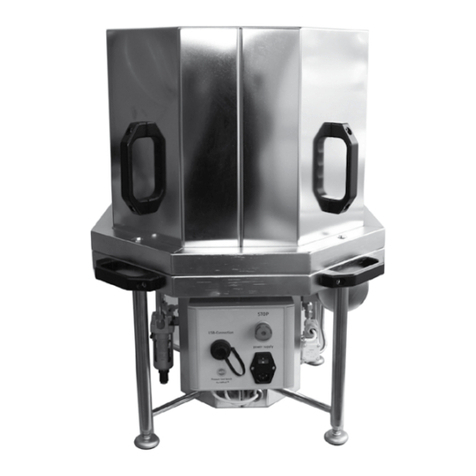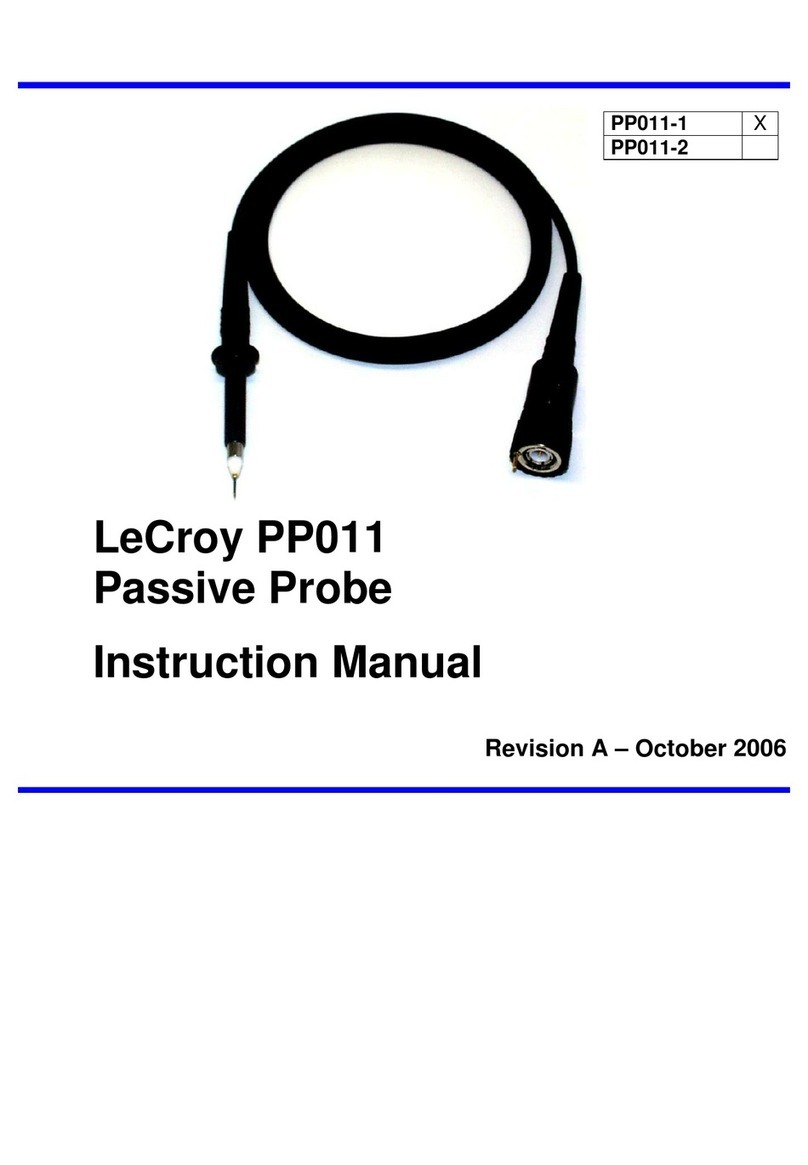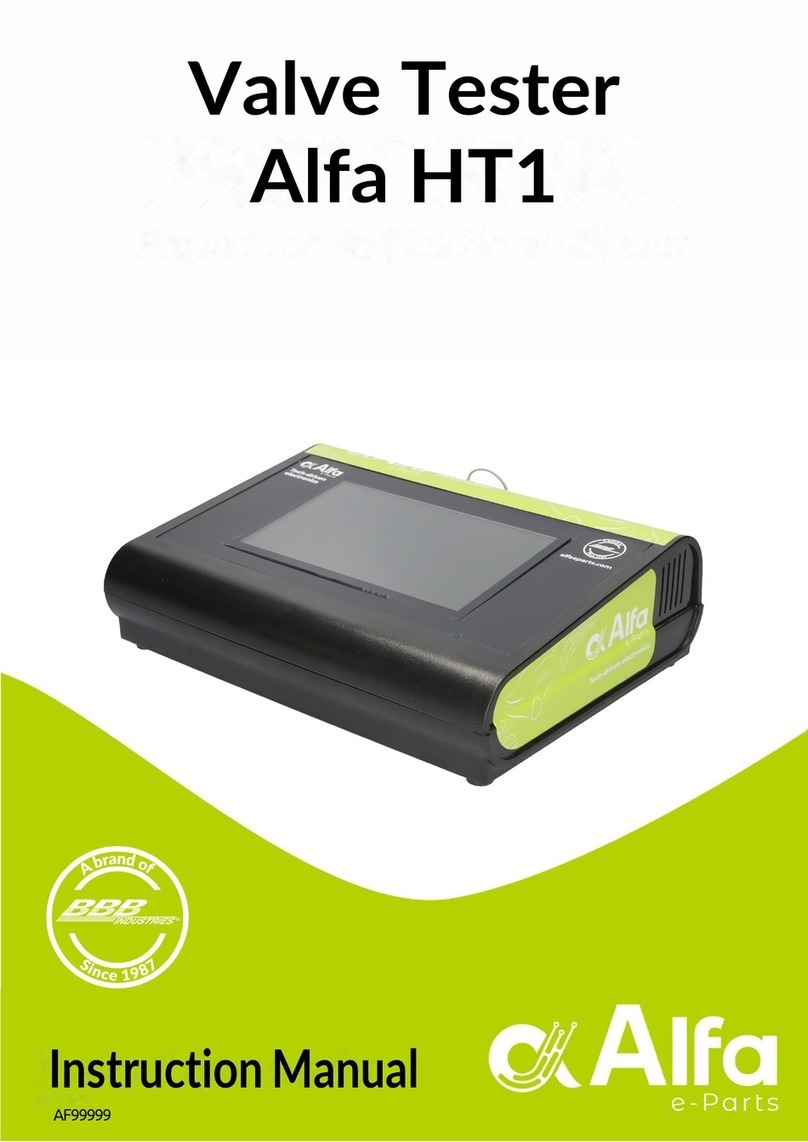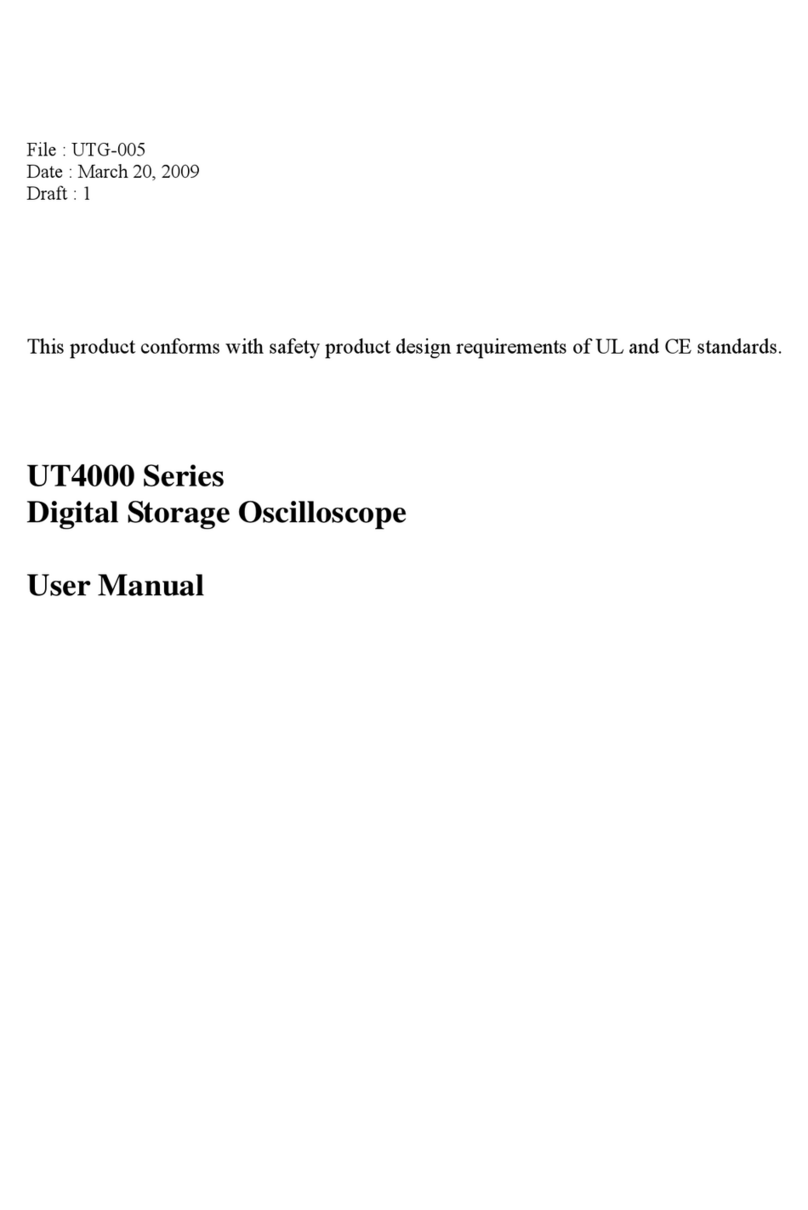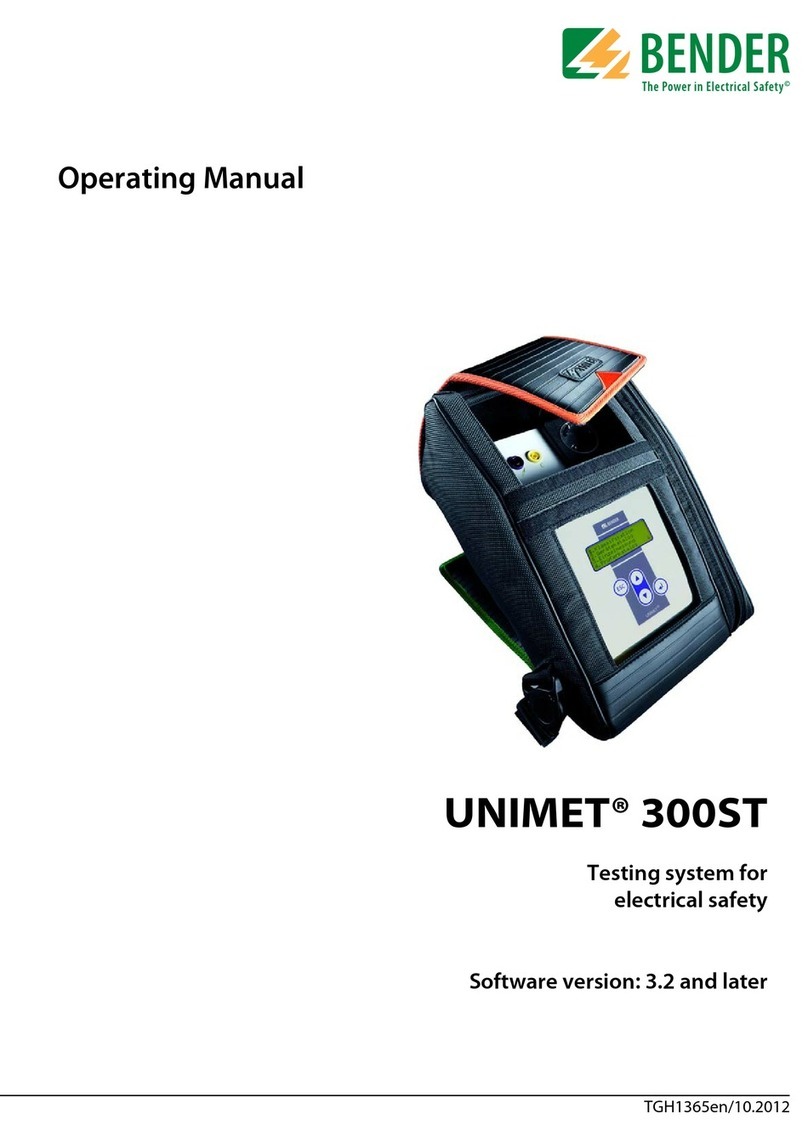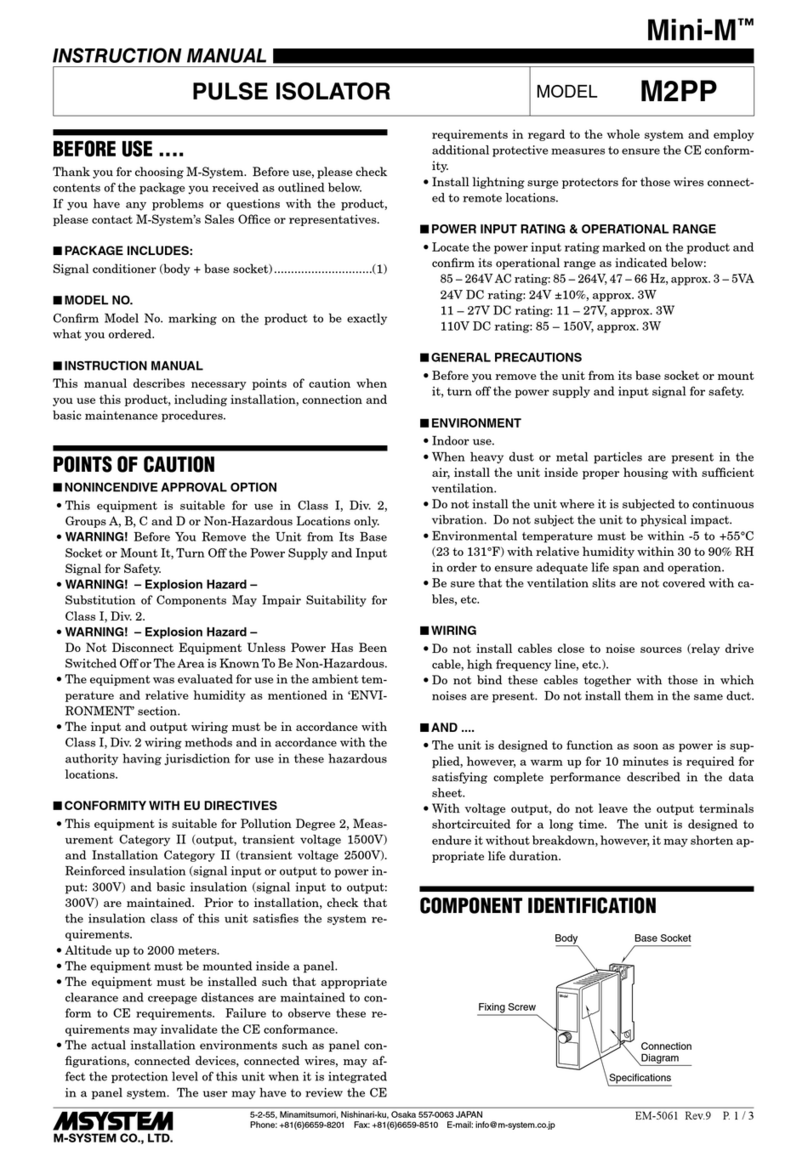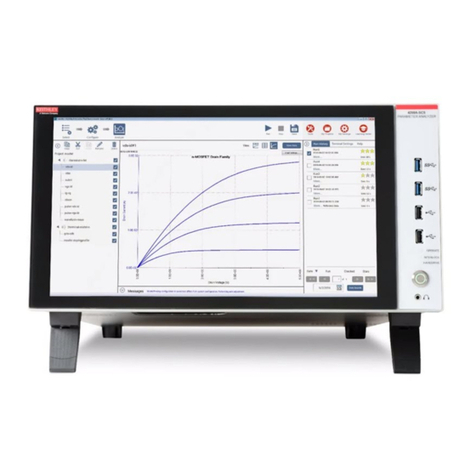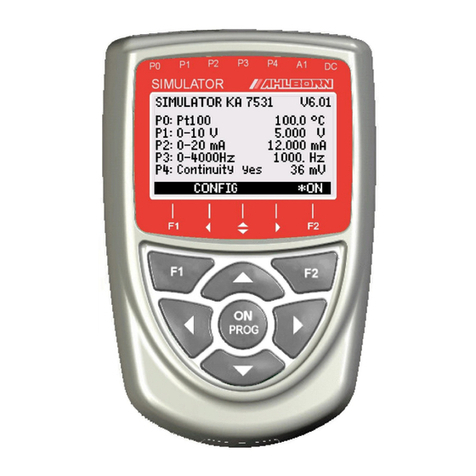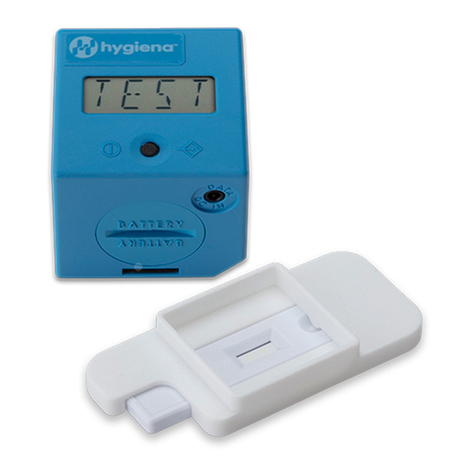MR MESSKO User manual

www.messko.com
MESSKO® Gas-Schnelltest / MESSKO® Gas Quick Test
Betriebsanleitung / Operating Instructions
BA3208538/00: deutsch
english

BA 3208538/002

BA 3208538/00 3
Inhaltsverzeichnis/Contents
Inhaltsverzeichnis
1 Sicherheit....................................4
1.1 Sicherheitshinweise............................4
1.2 Bestimmungsgemäße Verwendung ...............4
1.3 Hinweise für die Verwendung des Test-Sets........ 4
2 Produktbeschreibung .......................... 4
2.1 Wirkungsweise................................4
3 Montage, Vorbereitung und Auswertung.......... 4
3.1 Gasentnahmegerät ............................4
3.2 Verwendung des MESSKO® Gas-Schnelltest direkt am
MSafe Buchholzrelais ..........................6
4 Lieferumfang MESSKO® Gas-Schnelltest ..........7
Für zukünftige Verwendung aufbewahren!
HINWEIS
Die in dieser Betriebsanleitung enthaltenen Angaben
können von dem gelieferten Gerät abweichen.
Änderungen bleiben vorbehalten.
Contents
1 Safety .......................................8
1.1 Safety instructions ............................8
1.2 Specified application ..........................8
1.3 Important notes on equipment operation .........8
2 Product specification ..........................8
2.1 Mode of operation ............................8
3 Assembly, preparation and evaluation ............8
3.1 Gas sampler .................................. 8
3.2 Using the MESSKO® Gas Quick Test directly on the
MSafe Buchholz relay.........................10
4 Scope of supply for the MESSKO® Gas Quick Test...11
Please keep this manual for future reference!
NOTE
Data contained herein may differ in details from the
equipment delivered.
We reserve the right to make alterations without notice.

BA 3208538/004
1 Sicherheit
2 Produktbeschreibung
3 Montage, Vorbereitung und Auswertung
1 Sicherheit
1.1 Sicherheitshinweise
Alle Personen, die mit dem Betrieb des Geräts zu tun haben,
müssen
- fachlich ausreichend qualifiziert sein und
- diese Betriebsanleitung genau beachten.
Bei Fehlbedienung oder Missbrauch drohen Gefahren für
- Leib und Leben,
- das Gerät und andere Sachwerte des Betreibers und
- die Funktion des Gerätes.
In dieser Betriebsanleitung werden drei Arten von Sicher-
heitshinweisen verwendet, um wichtige Informationen
hervorzuheben.
WARNUNG
weist auf besondere Gefahren für Leib und Leben hin.
Ein Nichtbeachten dieser Hinweise kann zu schwersten
Verletzungen oder Tod führen.
ACHTUNG
weist auf Gefahren für das Gerät oder andere Sachwerte
des Betreibers hin. Ferner können Gefahren für Leib und
Leben nicht ausgeschlossen werden.
HINWEIS
weist auf wichtige Informationen zu einer konkreten
Thematik hin.
2 Produktbeschreibung
Der MESSKO® Gas-Schnelltest dient dazu, die Gase im
MESSKO® Gasentnahmegerät oder im MESSKO® Buch-
holzrelais auf das Vorhandensein von Kohlenmonoxid und
Wasserstoff zu prüfen. Es findet keine quantitative Analyse
der Gase statt.
2.1 Wirkungsweise
Zur qualitativen Analyse der Gase im Gasentnahmegerät oder
im Buchholzrelais wird an dessen Gasentnahmeventil ein
Y-Verbinder aufgeschraubt, der jeweils ein Prüfröhrchen zur
Überprüfung auf das Vorhandensein von Kohlenmonoxid und
das Vorhandensein von Wasserstoff aufnimmt. Nach Öffnen
des Gasentnahmeventils wird das enthaltene Gas bei ent-
sprechendem Druck (> 0,5 bar) durch die Prüfröhrchen nach
außen geleitet und führt ggfs. zu deren Verfärbung.
3 Montage, Vorbereitung und Auswertung
3.1 Gasentnahmegerät
Eine Gasentnahme gemäß BA 3178923 MESSKO® Gasentnah-
megerät Kapitel 4.2 hat vorbereitend stattgefunden oder ist
noch durchzuführen!
(1) Verschlusskappe (Bild 1/1) von Gasentnahmeventil (Bild
1/4) abschrauben).
(2) Y-Verbinder (Bild 1/2) auf Gasentnahmeventil (Bild 1/4)
aufschrauben und sicheren Sitz prüfen.
(3) Prüfröhrchen für die Kohlenmonoxid- und Wasserstoff-
Analyse mit Röhrchenöffner auf beiden Seiten aufschneiden
ACHTUNG
Der MESSKO® Gas-Schnelltest darf ausschließlich von
qualifiziertem, ausgebildetem Personal gemäß dieser
Anleitung durchgeführt werden.
Der Betreiber hat für die bestimmungsgemäße Verwendung
des Test-Sets Sorge zu tragen.
Unsachgemäß durchgeführte Arbeiten bei Verwendung
des Test-Sets - ohne Rücksprache mit Messko - sind aus
Sicherheitsgründen verboten!
1.2 Bestimmungsgemäße Verwendung
Der MESSKO® Gas-Schnelltest dient dazu, die Gase im
MESSKO® Gasentnahmegerät oder im MESSKO® Buch-
holzrelais auf das Vorhandensein von Kohlenmonoxid und
Wasserstoff zu prüfen.
1.3 Hinweise für die Verwendung des Test-Sets
Die nationalen Unfallverhütungsvorschriften sind vom
Anwender unbedingt einzuhalten.
Es wird besonders darauf hingewiesen, dass das Arbeiten an
aktiven, d.h. berührungsgefährlichen Teilen, nur zulässig ist,
wenn diese Teile spannungsfrei oder gegen direktes Berühren
geschützt sind.
Bei der Installation sind die nationalen Vorschriften zu
beachten.
WARNUNG
Beachten sie unbedingt die nationalen Brandschutz-
vorschriften und die Vorschriften für den Umgang mit
toxischen und brennbaren Gasen.
ACHTUNG
Glasbruchgefahr!

BA 3208538/00 5
(siehe Bild 2) und in Y-Verbinder (Bild 1/2) einsetzen. Der Pfeil
auf dem Prüfröhrchen gibt die Durchflußrichtung an.
Wird nur auf das Vorhandensein eines Fehlergases geprüft,
so kann der unbenutzte Ausgang des Y-Verbinder mittels
vorhandenem Verschlussstecker verschlossen werden.
(4) Einlassventil (Bild 1/5) und Gasentnahmeventil (Bild1/4)
öffnen, sodass die Gase aus dem Gasentnahmegerät durch
die Prüfröhrchen ausgeleitet werden. Der dafür notwendige
Druck innerhalb des Gasentnahmegerätes muss > 0,5 bar
betragen. Den steigenden Ölpegel im Schauglas beobachten
und das Einlassventil (Bild 1/5) und das Gasentnahmeventil
(Bild 1/4) schliessen, sobald der Ölpegel noch etwa 2 cm vom
oberen Rand des Schauglases entfernt ist.
(5) Hat eine chemische Reaktion in den Glasröhrchen
stattgefunden, so haben sich deren Inhaltsstoffe verfärbt. Im
Prüfröhrchen für Wasserstoff muss eine Verfärbung von grün
WARNUNG
Explosionsgefahr und Gefahr vor brennbaren und
toxischen Gasen!
Im Fehlerfall können im Gasentnahmegerät befindliche
Gase in Verbindung mit Luft ein explosives Gasgemisch
bilden. Rauchen oder funkenschlagende Arbeiten sind im
Gefahrenbereich verboten!
Das Einatmen von austretenden Gasen ist zu vermeiden, da
diese toxisch sein können.
Bild 2 Prüfröhrchenschneider
ACHTUNG
Die aufgeschnittenen Prüfröhrchen vorsichtig aufschnei-
den und vorsichtig in den Y-Verbinder einsetzen. Es
besteht die Gefahr einer Schnittverletzung.
ACHTUNG
Wasserstoff ist ein Indikator für einen thermischen und/
oder einen energetischen Fehlerfall.
WasserstoffKohlenmonoxid
Bild 1
(4)Gas entnahme-
ventil
(2) Y-Verbinder
(3) Prüfröhrchen
(1) Verschluss-
kappe
Gasfluss
(5) Einlass-
ventil
MESSKO® Gasentnahmegerät

BA 3208538/006
nach rötlich nach rostbraun stattfinden, um das Vorhanden-
sein von Wasserstoff zu bestätigen.
Im Prüfröhrchen für Kohlenmonoxid deutet eine Verfärbung
von weiß nach grün nach braun auf das Vorhandensein von
Kohlenmonoxid hin.
Wurden Fehlergase festgestellt, so wird eine weitergehende
Überprüfung des Transformators bzw. eine qualitative Analyse
dringend empfohlen.
(6) Gasentnahmeventil wieder schliessen, Prüfröhrchen vor-
sichtig entfernen und Y-Verbinder abschrauben. Verschluss-
kappe (Bild 1/1) wieder auf Gasentnahmeventil aufschrauben.
(7) Betriebsbereitschaft des Gasentnahmegeräts ggfs.
wieder herstellen (siehe BA 3178923 Kapitel 4.1 und Kap. 4.2).
3.2 Verwendung des MESSKO® Gas-Schnelltest
direkt am MSafe Buchholzrelais
(1) Verschlusskappe (Bild 3/2) von Gasentnahmeventil (Bild
3/1) abschrauben).
(2) Y-Verbinder (Bild 3/3) auf Gasentnahmeventil (Bild 3/1)
aufschrauben.
(3) Prüfröhrchen für die Kohlenmonoxid- und Wasserstoff-
Analyse mit Röhrchenöffner auf beiden Seiten aufschneiden
(siehe Bild 2) und in Y-Verbinder (Bild 3/3) einsetzen. Der Pfeil
auf dem Prüfröhrchen gibt die Durchflußrichtung an.
Wird nur auf das Vorhandensein eines Fehlergases geprüft,
so kann der unbenutzte Ausgang des Y-Verbinder mittels
vorhandenem Verschlussstecker verschlossen werden.
(4) Gasentnahmeventil (Bild 3/1) öffnen, sodass die Gase
aus dem MSafe Buchholzrelais durch die Prüfröhrchen
ausgeleitet werden. Der dafür notwendige Druck innerhalb
des Buchholzrelais muss > 0,5 bar betragen. Den steigenden
Ölpegel im Schauglas des Buchholzrelais beobachten und das
Gasentnahmeventil (Bild 3/1) schliessen, sobald der Ölpegel
am oberen Rand des Schauglases anliegt.
HINWEIS
Bei Kohlenmonoxid kann eine leichte Rauchentwicklung
beim Austritt aus dem Prüfröhrchen stattfinden.
WARNUNG
Explosionsgefahr und Gefahr vor brennbaren und
toxischen Gasen!
Im Fehlerfall können im Buchholzrelais befindliche Gase in
Verbindung mit Luft ein explosives Gasgemisch bilden. Rau-
chen oder funkenschlagende Arbeiten sind im Gefahrenbe-
reich verboten!
Das Einatmen von austretenden Gasen ist zu vermeiden, da
diese toxisch sein können.
ACHTUNG
Kohlenmonoxid deutet auf ein Problem in der Papieriso-
lierung hin.
WasserstoffKohlenmonoxid
Bild 3
(3) Y-Verbinder
(4) Prüfröhrchen
(1) Gasentnahme-
ventil
Gasfluss
(2) Verschluss-
kappe
MESSKO® MSafe® Buchholzrelais
ACHTUNG
Die aufgeschnittenen Prüfröhrchen vorsichtig aufschnei-
den und vorsichtig in den Y-Verbinder einsetzen. Es
besteht die Gefahr einer Schnittverletzung.

BA 3208538/00 7
(5) Hat eine chemische Reaktion in den Glasröhrchen statt-
gefunden, so haben sich deren Inhaltsstoffe verfärbt.
Im Prüfröhrchen für Wasserstoff muss eine Verfärbung von
grün nach rötlich nach rostbraun stattfinden, um das Vorhan-
densein von Wasserstoff zu bestätigen.
Im Prüfröhrchen für Kohlenmonoxid deutet eine Verfärbung
von weiß nach grün nach braun auf das Vorhandensein von
Kohlenmonoxid hin.
Wurden Fehlergase festgestellt, so wird eine weitergehende
Überprüfung des Transformators bzw. eine qualitative Analyse
dringend empfohlen.
(6) Das Gasentnahmeventil Bild 3/1) wieder schliessen,
Prüfröhrchen vorsichtig entfernen und Y-Verbinder abschrau-
ben. Verschlusskappe (Bild 3/2) wieder auf Gasentnahmeventil
aufschrauben.
(7) Betriebsbereitschaft des MSafe Buchholzrelais ggfs.
wieder herstellen (siehe BA 2722549).
4 Lieferumfang MESSKO®Gas-Schnelltest
Prüfröhrchen Kohlenmonoxid (5x)
Prüfröhrchen Wassersto (5x)
Röhrchenöner
Y-Verbinder
Verschlussstecker (2x)
Bedienungsanleitung
Transportkoer
HINWEIS
Bei Kohlenmonoxid kann eine leichte Rauchentwicklung
beim Austritt aus dem Prüfröhrchen stattfinden.
ACHTUNG
Kohlenmonoxid deutet auf ein Problem in der Papieriso-
lierung hin.
ACHTUNG
Wasserstoff ist ein Indikator für einen thermischen und/
oder einen energetischen Fehlerfall.
Lieferumfang

BA 3208538/008
1 Safety
2 Product specification
3 Assembly, preparation and evaluation
1 Safety
1.1 Safety instructions
All personnel involved in operation of this equipment must:
- be suitably qualified and
- strictly observe these operating instructions.
Improper operation or misuse can lead to
- serious or fatal injury,
- damage to the equipment and other property of the user
- a reduction in the efficiency of the equipment.
Safety instructions in this manual are presented in three
different forms to emphasize important information.
WARNING
This information indicates particular danger to life and
health. Disregarding such a warning can lead to serious
or fatal injury.
CAUTION
This information indicates particular danger to the
equipment or other property of the user. Serious or
fatal injury cannot be excluded.
NOTE
These notes give important information on a certain
issue.
2 Product description
The MESSKO® Gas Quick Test is used to test the gases in the
MESSKO® gas sampler or the Buchholz relay for the presence
of carbon monoxide and hydrogen. No quantitative analysis
of the gases is made.
2.1 Mode of operation
A Y-connector is screwed onto the gas withdrawal valve for
qualitative analysis of the gases in the gas sampler or in the
Buchholz relay. The Y-connector holds two detector tubes for
testing the presence of carbon monoxide and the presence
of hydrogen respectively. After opening the gas withdrawal
valve, the gas contained is routed at an appropriate pressure
(> 0.5 bar) to the outside through the detector tubes and
leads where applicable to their discolouration.
3 Assembly, preparation and evaluation
3.1 Gas sampler
Gas withdrawal in accordance with BA 3178923 MESSKO®
Gas sampler, section 4.2, has been carried out in preparation
or is still to be carried out!
(1) Unscrew the sealing cap (Fig. 1/1) from the gas withdra-
wal valve (Fig. 1/4).
(2) Screw the Y-connector (Fig. 1/2) onto the gas withdra-
wal valve (Fig. 1/4) and check if the connector is tightened
properly.
(3) Cut open the detector tubes for the carbon monoxide
and hydrogen analysis on both sides using the tube cutter
1.2 Specified application
The MESSKO® Gas Quick Test is used to test the gases in the
MESSKO® gas sampler or the MESSKO® Buchholz relay for
the presence of carbon monoxide and hydrogen.
1.3 Important notes on equipment operation
The user is advised to strictly comply with the national acci-
dent prevention regulations.
It is especially emphasized that work on active or live compo-
nents is only permissible while these components are either
de-energized or protected against direct contact.
Installation is subject to the relevant national safety regu-
lations.
WARNING
All relevant fire protection regulations and specifications
for handling toxic and flammable gases must be strictly
observed.
CAUTION
The MESSKO® Gas-Quick Test may only be carried out by
qualified, skilled personnel and only in accordance with
these instructions.
It is the responsibility of the user to make sure that the
test set is used for the specified application only.
For safety reasons, any unauthorized and improperly
executed usage of the test set, are forbidden without
first consulting Messko!
CAUTION
Danger of glass breakage!

BA 3208538/00 9
(see Fig. 2) and insert into the Y-connector (Fig. 1/2). The
arrow on the detector tube indicates the gas flow direction.
If the test is only being carried out to verify the presence of a
fault gas, the unused outlet of the Y-connector can be sealed
off using the sealing cap provided.
(4) Open the inlet valve (Fig. 1/5) and the gas withdrawal
valve (Fig. 1/4) so that the gases can be routed out of the gas
sampler through the detector tubes. The necessary pressure
for this inside the gas sampler must be > 0.5 bar. Observe the
rising oil level in the inspection window and close the inlet
valve (Fig. 1/5) and the gas withdrawal valve (Fig. 1/4) as soon
as the oil level is still approximately 2 cm from the top edge
of the inspection window.
(5) If a chemical reaction has taken place in the glass tubes,
then their contents will have discoloured. A discolouration
from green to reddish to rust brown must take place in the
detector tube for hydrogen in order to confirm the presence
of hydrogen.
WARNING
Risk of explosion and risk of flammable and toxic gases!
In the event of an error, gases in the MESSKO® Gas sampler
may form an explosive gas mixture in connection with
air. Smoking or work involving sparks is prohibited in the
hazard area!
Avoid breathing in any gases escaping as they may be toxic.
Fig. 2 Detector tube cutter
CAUTION
Carefully cut open the detector tubes and cautiously
insert them into the Y-connector. There is a risk of injury
due to cuts.
HydrogenCarbon monoxide
Fig. 1
(4) Gas withdrawal
valve
(2) Y-connector
(3) Detector tubes
(1) Sealing
cap
Gas flow
(5) Inlet
valve
MESSKO® Gas sampler

BA 3208538/0010
A discolouration in the detector tube for carbon monoxide
from white to green to brown indicates the presence of
carbon monoxide.
If fault gases have been detected, it is urgently recommended
to carry out an extensive examination of the transformer or
to carry out a qualitative analysis.
(6) Close the gas withdrawal valve again, carefully remove
the detector tubes and unscrew the Y-connector. Screw the
sealing cap (Fig. 1/1) back onto the gas withdrawal valve.
(7) If necessary, re-establish the gas sampler’s operational
readiness (see BA 3178923 section 4.1 and section 4.2).
3.2 Using the MESSKO® Gas Quick Test directly on
the MSafe Buchholz relay
(1) Unscrew the sealing cap (Fig. 3/2) from the gas withdra-
wal valve (Fig. 3/1).
(2) Screw the Y-connector (Fig. 3/3) onto the gas withdra-
wal valve (Fig. 3/1).
(3) Cut open the detector tubes for the carbon monoxide
and hydrogen analysis on both sides using the tube opener
(see Fig. 2) and insert into the Y-connector (Fig. 3/3). The
arrow on the detector tube indicates the gas flow direction.
If the test is only being carried out to verify the presence of a
fault gas, the unused outlet of the Y-connector can be sealed
off using the sealing plug provided.
(4) Open the gas withdrawal valve (Fig. 3/1) so that the
gases can be routed out of the MSafe Buchholz relay through
the detector tubes. The necessary pressure for this inside the
NOTE
In the case of carbon monoxide, there may be a small
amount of smoke formation on escaping from the
detector tube.
CAUTION
Carbon monoxide is an indicator of problems in paper
insulation.
Buchholz relay must be > 0.5 bar. Observe the rising oil level
in the inspection window of the Buchholz relay and close the
ACHTUNG
Carefully cut open the detector tubes and cautiously
insert them into the Y-connector. There is a risk of injury
due to cuts.
WARNUNG
Risk of explosion and risk of flammable and toxic gases!
In the event of an error, gases in the MESSKO® Buchholz
relay may form an explosive gas mixture in connection with
air. Smoking or work involving sparks is prohibited in the
hazard area!
Avoid breathing in any gases escaping as they may be toxic.
HydrogenCarbon monoxide
Fig 3
(3) Y-connector
(4) Detector tubes
(1) Gas
withdrawal
valve
Gas flow
(2) Sealing
cap
MESSKO® MSafe® Buchholz relay
CAUTION
Hydrogen is an indicator of thermal and / or energy
error.

BA 3208538/00 11
gas withdrawal valve (Fig. 3/1) as soon as the oil level is at
the top edge of the inspection window.
(5) If a chemical reaction has taken place in the glass tubes,
then their contents will have discoloured. A discolouration
from green to reddish to rust brow must take place in the
detector tube for hydrogen in order to confirm the presence
of hydrogen.
A discolouration in the detector tube for carbon monoxide
from white to green to brown indicates the presence of
carbon monoxide.
If fault gases have been detected, it is urgently recommended
to carry out an extensive examination of the transformer or
to carry out a qualitative analysis.
(6) Close the gas withdrawal valve (Fig. 3/1) again, carefully
remove the detector tubes and unscrew the Y-connector.
Screw the sealing cap (Fig. 3/2) back onto the gas withdrawal
valve.
(7) If necessary, re-establish the MSafe Buchholz relay’s
operational readiness (see BA 2722549).
4 Scope of supply for the MESSKO®Gas Quick Test
Detector tubes for carbon monoxide (5)
Detector tubes for hydrogen (5)
Detector tube cutter
Y-connector
Sealing plug (2)
Operating instructions
Transportation case
CAUTION
Hydrogen is an indicator of thermal and / or energy
error.
NOTE
In the case of carbon monoxide, there may be a small
amount of smoke formation on escaping from the
detector tube.
CAUTION
Carbon monoxide is an indicator of problems in paper
insulation.
4 Scope of supply for the MESSKO®Gas Quick Test

BA 3208538/0012
Bitte beachten: Die in allen unseren Publikationen enthaltenen Angaben
können in Details von dem gelieferten Gerät abweichen. Änderungen bleiben
vorbehalten.
Please note: The data in our publications may differ from the data of the
devices delivered. We reserve the right to make changes without notice.
Messko GmbH Phone: +49 (0)6171/ 6398- 0
Gewerbegebiet An den Drei Hasen Fax: +49 (0)6171/ 6398- 98
D-61440 Oberursel/Taunus www.messko.com
www.messko.com
BA3208538/00 DE/EN • 11/12 • Art. Nr./Art. no. 78536100 • Printed in Germany • ©Messko GmbH 2012
Table of contents
Languages:
Other MR Test Equipment manuals
Popular Test Equipment manuals by other brands
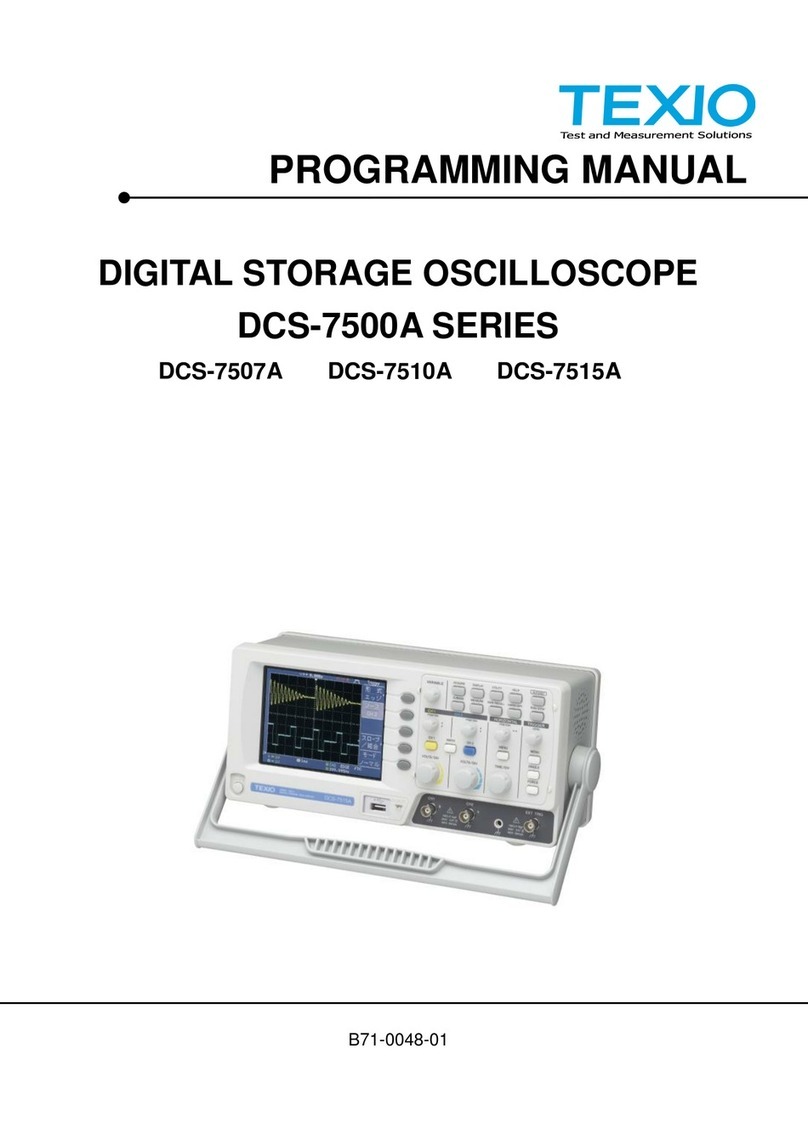
TEXIO
TEXIO DCS-7500A Series Programming manual
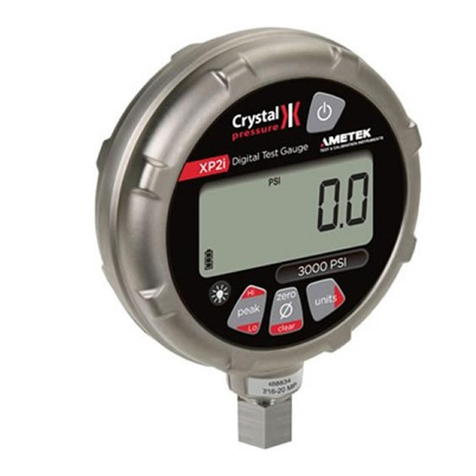
Ametek
Ametek XP2i Operation manual

Ozito
Ozito OCBT-1200 instruction manual

Aeroflex
Aeroflex GPSG-1000 Application note

Simons Voss Technologies
Simons Voss Technologies WaveNet-Funktester quick guide
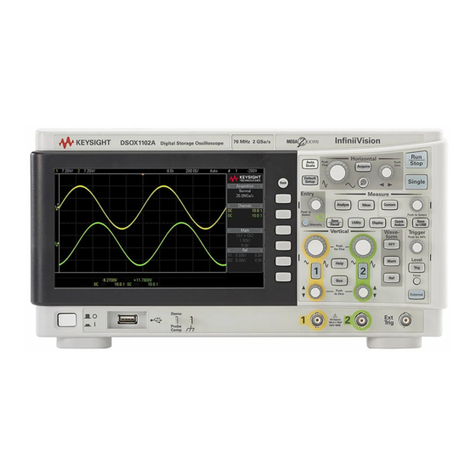
Keysight Technologies
Keysight Technologies InfiniiVision 1000 X-Series Service guide
